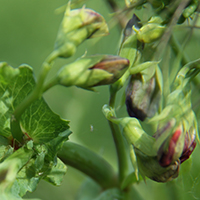Suitability of NDVI index to pea condition evaluation at diverse phosphorus fertilization

Accepted: 19 February 2020
HTML: 49
All claims expressed in this article are solely those of the authors and do not necessarily represent those of their affiliated organizations, or those of the publisher, the editors and the reviewers. Any product that may be evaluated in this article or claim that may be made by its manufacturer is not guaranteed or endorsed by the publisher.
In this 3-year study the suitability of the normalized differenced vegetation index (NDVI) to the evaluation of pea plant infestation by aphids and expected seeds yield was investigated. The effect was assessed in the conditions of the increasing doses of phosphorus fertilization (0, 70, and 140 kg P2O5 ha–1) and in the different pea aphid (Acyrthosiphon pisum Harris) occurrence on six various cultivars of pea. Independent of the dose, the phosphorus fertilization supported the occurrence of aphids on pea plants of Batuta, Model, and Protecta cultivars where in Tarchalska and Mecenas cultivars only the standard dose (70 kg ha–1) showed such effect. NDVI index was not clearly, unambiguously correlated to the intensity of A. pisum occurrence. Such factors as the deficiency or excessive amount of phosphorus, as well as meteorological conditions and the cultivar of host plant had the greater effect on its value than the presence of aphids. All this testifies that the NDVI index is not reliable indicator of aphid occurrence on pea, however it can offer a promising method to select the cultivars under sub-opitmal conditions. The seed yield was strongly related to agronomical factors (fertilization, cultivars) and plant (NDVI) variable, while marginally to environmental variable (aphids).
How to Cite
PAGEPress has chosen to apply the Creative Commons Attribution NonCommercial 4.0 International License (CC BY-NC 4.0) to all manuscripts to be published.

 https://doi.org/10.4081/ija.2020.1418
https://doi.org/10.4081/ija.2020.1418



